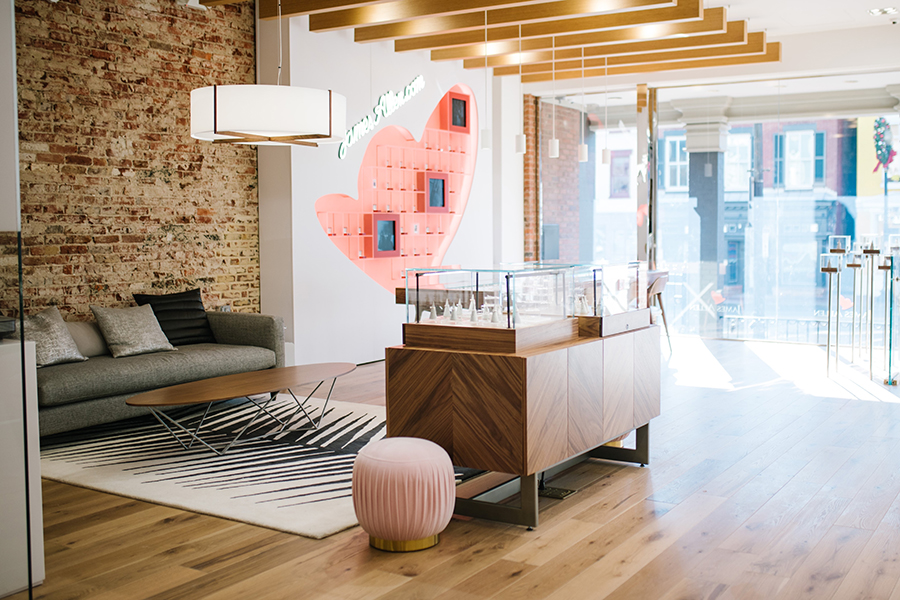Adding the right sparkle in jewellery store design
By Retail4Growth Bureau | April 01, 2024
Cracking the store experience code in the Indian jewellery market requires a deep understanding of several high-level nuances and peculiar customer buying behaviours, says Chanda P Kumar, Associate Director- Marketing & Communications, Strategy – FRDC, in this exclusive column for Retail4Growth. Also, don’t miss the tips shared by Sanjay Agarwal, Co-Founder, FRDC.
 The demand for jewellery has always been very high in India and continues to be so, given the unparalleled jewellery legacy that the country has. From heritage based, iconic statement pieces, to more edgy, contemporary and crafted offerings, the jewellery segment in India has evolved to offer a plethora of new choices to the customers of today.
The demand for jewellery has always been very high in India and continues to be so, given the unparalleled jewellery legacy that the country has. From heritage based, iconic statement pieces, to more edgy, contemporary and crafted offerings, the jewellery segment in India has evolved to offer a plethora of new choices to the customers of today.
We also see a change in how jewellery is bought today, impacted by global trends and influences. There is a transition from just traditional or occasion-led jewellery to jewellery for work wear, everyday wear, party wear and more. Increasingly people want to live by the dictum - ‘celebrate today and live in the present’.
Indian jewellery market on growth trajectory
Not surprisingly, the Indian jewellery market is experiencing a significant growth trajectory, with the jewellery retail trade expected to expand by 10-12% in FY24, according to ICRA. This growth is being driven by various factors including, rising disposable incomes and a shift towards design-led, bespoke, and high-quality jewellery among consumers. Organised jewellery retailers are expected to outperform the industry, thanks to planned retail expansion and the formalisation of the trade. This trend is evident with the announcement of new entrants, such as the Aditya Birla Group, which is set to launch a branded jewellery retail business with an investment of Rs 5,000 crore. On the other hand, Titan had announced to open an invite-only retail store offering luxury jewellery with a minimum ticket size of ₹10 lakh, highlighting a broader trend of consumer companies premiumising their offerings to tap into the strong demand for high-end products.
The importance of offline retail in driving the growth of the jewellery market is immense. Despite the rise of online shopping, leading brands are witnessing that customers still prefer the in-store experience for obvious reasons - the sheer joy of shopping that online cannot provide, shopping as a special occasion in people's lives and the need for tactile and visual experience.
The evolving landscape of jewellery buying has also highlighted the need to re-evaluate how the in-store experience can be enhanced for today's discerning customers. There are stark differences in store design and experience among brands that cater to various segments of the jewellery market. Cracking the store experience code in the Indian jewellery market requires a deep understanding of several high-level nuances and peculiar customer buying behaviours.
When design conveys the unique brand narrative
Each brand has its unique story, whether it's about legacy, craftsmanship, cultural significance, or inclusivity, it's essential to communicate the brand story effectively in-store to stand out in the crowded jewellery retail landscape.
For brands with a long legacy, highlighting their humble beginnings and the trust they've built over the decades can resonate deeply with customers who value heritage and longevity. On the other hand, brands rooted in traditional craftsmanship can connect with customers by showcasing regional traditions and cultural influences that speak to their target audience.

In Swadesh, fine jewellery from multiple craft-styles and regional influences is showcased in a space that matches their sense of luxury with segmented areas–leveraging the lavishness of rich woods and handwoven fabrics–providing more intimate browsing and consultation experience.
There's also a new wave of brands focusing on inclusivity, affordability, and wearability, aiming to make jewellery more accessible and joyful for a wider audience. These brands often emphasize their contemporary designs and versatile styles, appealing to a younger, trend-conscious demographic.
Right ambience for the right vibe
Jewellery remains a special buy for most, and creating the right vibe at the store can go beyond the stereotype. There are many ways to reflect this.
Some brands opt for opulent and luxurious designs in their stores to convey a sense of exclusivity. These stores often use high-end materials, intricate displays and connect to heritage craftsmanship, and lighting that create a lavish and indulgent atmosphere, appealing to customers looking for a luxurious shopping experience.

The goal in the remodel of Tapper’s luxury mall destination was to immerse Millennials and Gen Z consumers in an environment that expands to highlight storytelling, authenticity, and craftsmanship. The “origami-like” metallic finish ceiling acts as a dramatic background to the store’s gunmetal and edge-lit sign, carried horizontally into the store and terminating in the focal digital wall that features lifestyle, fashion, brand and designer stories and images.
On the other hand, some brands choose minimalistic or playful designs to cater to a more modern and casual audience. These stores may feature clean lines, simple layouts, and contemporary decor, creating a relaxed and approachable ambience that resonates with customers seeking a more laid-back shopping experience.
Enabling memory making
Today, we are in the age of capturing our memories – small or big – and sharing it with the rest of the world via social media. And since jewellery is a purchase that commonly celebrates a milestone in people’s lives, whether it’s the first pay check or a gift for Mother’s Day, it should be matched with an equal level of memorable experience.
One way to amplify these moments is by offering interactive features in-store, such as a photobooth or an intimate booth for privacy, where customers can capture and share their special moments. These features not only add a fun and personal touch to the shopping experience but also encourage customers to share their experiences on social media, creating a buzz around the brand.

They wanted to create an immersive customer experience unlike any other from jewellery retailers. JGA designed a series of experiential zones where customers can relax, hang out and “play” with products.
Another way to enhance the experience is through gift wrapping and personalization services. Offering beautifully wrapped gifts and personalized touches, such as engraving or custom designs, can make the purchase feel even more special and meaningful.
By focusing on creating memorable experiences that go beyond the transactional aspect of buying jewellery, brands can build stronger connections with their customers and create lasting impressions that drive loyalty and advocacy.

James Avery store encourages customer engagement, the store design celebrating the joy of gifting and personalization with its ‘Workshop’ zone.
The Family Buy
Finally, traditional or occasion-based jewellery buying such as bridal jewellery is still a sizeable portion in India. And these shopping trips are usually a multi-generational family- affair. To cater to this unique dynamic, brands need to create inclusive and welcoming store environments that cater to the needs and preferences of all family members. This can include comfortable seating areas for elderly family members, private viewing rooms, refreshments, options to engage kids and ensuring that staff members are attentive to all customers, regardless of age or background.
Six Tips for Enhancing Store Experience in Jewellery Retail
By Sanjay Agarwal, Co-Founder, FRDC

1. Bring Fresh Perspective
- Most Indian jewellery brands are now run by 3rd or 4th generation of the founding family, however the store experience remains dated and the same. There is a need to apply fresh narratives and perspective. We need to question all functionality related aspects, while having a new approach for the solution.
2. Counters and Display
- The most comfortable viewing area is between the waist and the eyes. Raising display counters to a more comfortable viewing height provides a more ergonomic viewing experience, reducing strain on the neck and back. Avoid overload or overspread that can indeed enhance the shopping experience. This approach can help create a more visually appealing and relaxing environment for customers, allowing them to focus on individual pieces without feeling overwhelmed.
3. Guide, Guide, Guide!
- Convert desires into wants and then into needs! That’s the key in Jewellery store. So the more you advice & guide, the more you build trust and connect with customers. Although you are the expert here, listen keenly to customers and what they seek. By using devices and communications, you can help in imparting accurate information. As it’s an expensive affair, all written information will have high validity.
4. Design and Comfort matters
- Being just a trusted jeweller doesn’t make the cut these days, as people now know what is relevant and why they need it. So, how you display your best designs is the key to entice customer and make him/her feel at ease. Small details matter, such as the design of VM props, the fragrance, ergonomic chairs, glassware you serve water in and more. Also, it is extremely critical to treat space acoustically well so as to keep ambient sound levels quite low in the store. One group of customers should not be able to overhear another group, hence use of rugs/carpets, softer upholstery come in play here.
5. Lighting, Lighting, Lighting
- Lighting can make or break the purchase decision of jewellery, especially in stone/diamond studded. In-counter light, indirect light, diffused light and right colour temperature for Gold vs Diamond vs Silver is utmost critical. Even the best showrooms of big brands lack in appropriate lighting. Most times this factor is overlooked or discounted due to budget constraints. One can save costs on other build materials, but never on lighting. Jewellery display requires extremely narrow and pin-point focus lights and that too of lower wattage so that the products glow and not shine. Product level lighting should be higher than ambient lighting. Natural light should be harnessed cleverly to create a daylight canvas which is also key. Glare should be cut as much as possible. Glasses used in display counters and walls should be anti-reflective in nature. It’s important to provide inbuilt lights inside cases and avoid light striking on glass. The backdrop materials of display would absorb light and not reflect. Always provide dimmable & tunable lights so that they can be adjusted, depending upon designs & colours of the products.
6. Technology-enabled but served by Humans
- Use of technology should be much more than just a display of screens. It must be an enabling tool for informing/educating customers on how the jewellery is made, narrate story behind craft/stones and tips on how to maintain and preserve the jewellery. Avoid using large broadcasting screens as jewellery is an intimate product. Machines to check purity, carats etc., can be displayed neatly and in a transparent manner.


_165_265.jpg)
_165_265.jpg)


_140_270.png)


Comments